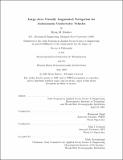| dc.contributor.advisor | Hanumant Singh and John J. Leonard. | en_US |
| dc.contributor.author | Eustice, Ryan M | en_US |
| dc.contributor.other | Woods Hole Oceanographic Institution. | en_US |
| dc.date.accessioned | 2007-10-19T21:05:35Z | |
| dc.date.available | 2007-10-19T21:05:35Z | |
| dc.date.copyright | 2005 | en_US |
| dc.date.issued | 2005 | en_US |
| dc.identifier.uri | http://hdl.handle.net/1721.1/39227 | |
| dc.description | Thesis (Ph. D.)--Joint Program in Applied Ocean Science and Engineering (Massachusetts Institute of Technology, Dept. of Ocean Engineering; and the Woods Hole Oceanographic Institution), 2005. | en_US |
| dc.description | This electronic version was submitted by the student author. The certified thesis is available in the Institute Archives and Special Collections. | en_US |
| dc.description | Includes bibliographical references (p. 173-187). | en_US |
| dc.description.abstract | This thesis describes a vision-based, large-area, simultaneous localization and mapping (SLAM) algorithm that respects the low-overlap imagery constraints typical of autonomous underwater vehicles (AUVs) while exploiting the inertial sensor information that is routinely available on such platforms. We adopt a systems-level approach exploiting the complementary aspects of inertial sensing and visual perception from a calibrated pose-instrumented platform. This systems-level strategy yields a robust solution to underwater imaging that overcomes many of the unique challenges of a marine environment (e.g., unstructured terrain, low-overlap imagery, moving light source). Our large-area SLAM algorithm recursively incorporates relative-pose constraints using a view-based representation that exploits exact sparsity in the Gaussian canonical form. This sparsity allows for efficient O(n) update complexity in the number of images composing the view-based map by utilizing recent multilevel relaxation techniques. We show that our algorithmic formulation is inherently sparse unlike other feature-based canonical SLAM algorithms, which impose sparseness via pruning approximations. In particular, we investigate the sparsication methodology employed by sparse extended information filters (SEIFs) and offer new insight as to why, and how, its approximation can lead to inconsistencies in the estimated state errors. Lastly, we present a novel algorithm for efficiently extracting consistent marginal covariances useful for data association from the information matrix. | en_US |
| dc.description.abstract | (cont.) In summary, this thesis advances the current state-of-the-art in underwater visual navigation by demonstrating end-to-end automatic processing of the largest visually navigated dataset to date using data collected from a survey of the RMS Titanic (path length over 3 km and 3100 m² of mapped area). This accomplishment embodies the summed contributions of this thesis to several current SLAM research issues including scalability, 6 degree of freedom motion, unstructured environments, and visual perception. | en_US |
| dc.description.statementofresponsibility | by Ryan M. Eustice. | en_US |
| dc.format.extent | 187 p. | en_US |
| dc.language.iso | eng | en_US |
| dc.publisher | Massachusetts Institute of Technology | en_US |
| dc.rights | M.I.T. theses are protected by copyright. They may be viewed from this source for any purpose, but reproduction or distribution in any format is prohibited without written permission. See provided URL for inquiries about permission. | en_US |
| dc.rights.uri | http://dspace.mit.edu/handle/1721.1/7582 | |
| dc.subject | /Woods Hole Oceanographic Institution. Joint Program in Applied Ocean Science and Engineering. | en_US |
| dc.subject | Ocean Engineering. | en_US |
| dc.subject | Woods Hole Oceanographic Institution. | en_US |
| dc.subject.lcsh | Underwater imaging systems | en_US |
| dc.subject.lcsh | Underwater navigation | en_US |
| dc.subject.lcsh | Submersibles | en_US |
| dc.title | Large-area visually augmented navigation for autonomous underwater vehicles | en_US |
| dc.type | Thesis | en_US |
| dc.description.degree | Ph.D. | en_US |
| dc.contributor.department | Joint Program in Applied Ocean Physics and Engineering | en_US |
| dc.contributor.department | Woods Hole Oceanographic Institution | en_US |
| dc.contributor.department | Massachusetts Institute of Technology. Department of Ocean Engineering | |
| dc.identifier.oclc | 64030824 | en_US |
